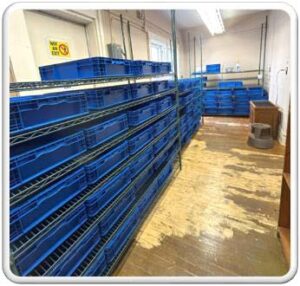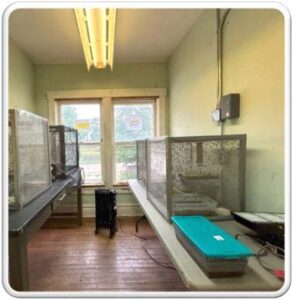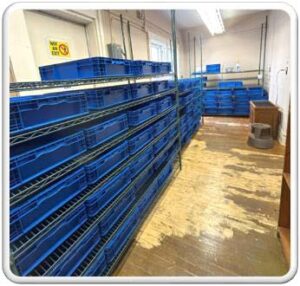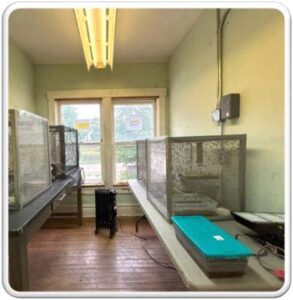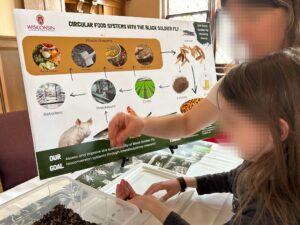Progress report for LNC23-482
Project Information
Title: Advancing sustainable agriculture through insect farming
Insect farming, particularly of Hermetia illucens, the Black Soldier Fly (BSF), is a growing sector of American and global agriculture. BSF larvae efficiently convert organic waste into valued products including animal protein, oils, chitin, and organic fertilizer. BSF larvae likely have a minimal environmental footprint and have been approved in the US as a source of protein and fat in poultry, swine, and salmonid feed. BSF farming may thus present an opportunity for farmers in the North Central Region to create local feed supply chains, diversify their income sources, and increase the circularity and sustainability of their business activities. However, while there is good evidence for the nutritional performance of BSF-based feeds, little is known about the conditions necessary for sustainable BSF farming. The proposed project aims to assist small-scale poultry farmers in the North Central Region in deciding whether to produce BSF larvae. In Objective 1, we will establish a prototype BSF farm at UW-Madison. In Objective 2, we will use an interdisciplinary approach to evaluate the nutritional quality, environmental sustainability, and economic viability of BSF products using locally-sourced agricultural and consumer waste streams. In Objective 3, we will build educational knowledge and supporting networks for BSF farming through in-person and virtual workshops, multi-modal training materials, and mentorship from established farmers. In Objective 4, we will facilitate focus group discussions to understand poultry farmers’ perceptions regarding barriers and conduits to BSF farming. Overall, this project will improve awareness and knowledge of BSF farming, facilitating decisions about whether to adopt this practice in the North Central Region. Uptake of BSF farming could improve agricultural sustainability by recycling waste into valued products, stimulate additional economic activity in rural communities, and reduce reliance on soy- and fish-based feeds that can have high environmental and economic costs. Our research findings, along with our outreach program, will provide valuable resources to inform extension programming and the ongoing efforts to develop sustainable feed chains in the North Central region, and potentially serve as a model for national and global sustainability efforts.
Learning Outcomes:
- Researchers will learn about nutritional, economic, and environmental outcomes of BSF production using locally-sourced waste streams.
- Poultry farmers will build awareness and knowledge of BSF larvae as a feed ingredient and waste reduction tool.
- Researchers will learn about perceived barriers and conduits to BSF production in the North Central Region.
Action Outcomes:
- Researchers will establish a prototype BSF farm for research and extension activities in the North Central Region.
- Poultry farmers will make informed decisions about whether to adopt BSF production, with potential for improving agricultural sustainability in the North Central Region.
Finding alternative feeds: The global supply of protein for animal feed is insufficient to meet potential demand, so protein availability can be a limiting ingredient in the value chain. Protein feed amendments are also expensive and resource-intensive to generate. As the world population increases, demand for animal-sourced foods and thus feed supplies will continue to grow, with potential for limited availability and higher prices (Kim et al., 2019). Our team has heard from farmers in the North Central Region about the need for alternative feed sources in poultry, swine, and aquaculture diets. Organic farmers have been especially affected by surging organic soybean meal prices, which can be twice the cost of conventional meal. Moreover, both farmers and consumers are concerned about the environmental impact of feed production. Alternative high-quality protein sources could increase sustainability in the feed value chain, while supporting increased food animal production.
Insects–specifically BSF–could address feed supply challenges, as they are more resource-efficient than other protein sources and can be reared on and valorize low-cost organic side-streams, agricultural byproducts, and biowaste that might otherwise be unusable (Makkar et al., 2014). Insects are part of the natural diet for poultry and many types of fish, so it is unsurprising that BSF have been widely recognized as a safe and healthy feed alternative for poultry, swine, and aquaculture and have been approved for use in the USA, EU, Canada, and Australia (Alagappan et al., 2022). BSF larvae are nutrient-dense and protein rich, containing well-balanced essential amino acid profiles and fatty acids similar to those found in fish and soybean meal (Makkar et al., 2014). They also contain essential minerals and vitamins, but unlike plant proteins, are lower in anti-nutrient factors. Complete or partial replacement of other feed proteins with BSF larvae in poultry, swine, or aquaculture diets has been shown to support animal health and performance, while potentially reducing feeding costs and promoting higher economic returns (Abd El-Hack et al., 2020, Nairuti et al., 2021, Veldkamp and Vernooij, 2021). BSF larvae may offer more than nutrients, as they could also have welfare- and health-promoting properties for animals that consume them due to their composition including fibers (chitin), bioactive compounds, and their presence in natural diets (Dörper et al., 2021).
Managing food waste: Roughly one third of the world’s food meant for human consumption - approximately 1.6 billion metric tons - is lost or wasted each year. This wasted food releases approximately 2.2 billion metric tons of CO2 (Porter et al., 2016). In the United States, 40% of the food we produce is discarded, and since little is composted, most ends up in landfills, generating about 16% of the US-produced climate-change-accelerating methane gas (EPA, 2012). If global food waste were a country, it would be the third largest emitter of greenhouse gasses (UNEP Food Waste Index Report, 2021).
Addressing food waste challenges by diverting it from landfills is one crucial step in reducing greenhouse gas emissions and improving the efficiency of the food system. Insects, such as BSF, are gaining traction as a potential solution to food waste challenges, given their ability to efficiently convert low-quality organic waste into body mass containing high quality protein and valuable oils (Surendra et al., 2020). Farming insects is also environmentally advantageous due to their short lifespans, exponential reproductive capacity, high feed conversion efficiency, and poikilothermic nature—meaning that they do not expend energy maintaining their body temperature (Moruzzo et al., 2021). BSF are considered a non-pest, as they are not known to invade human living environments, spread diseases, or harm crops. They can also digest pathogenic microbes, such as Salmonella spp. and Escherichia coli, thereby reducing the harmful effect of such waste on the environment (Surendra et al., 2020).
Supporting economic development: A region’s economic prosperity is tightly linked to its capacity to quickly recover from or avoid major disturbances to its economic base. Autonomy over feed may improve farm resiliency by reducing feeding costs and exposure to volatile feed prices and supply shortages (Perrin et al., 2020). Thus, growing BSF feed could strengthen the resiliency and growth of rural economies by allowing farmers to exert more control over their supply chain, particularly if BSF production is more resilient to adverse events than producing crops for feed. In addition to self-provision of feed, adding a BSF operation to poultry farms may create opportunities for farmers to diversify revenue streams, as the larvae can be sold as a raw material for the extraction of antimicrobial peptides, chitin, and chitosan, and the insect residue can serve as a high-quality fertilizer. It is likely that the market for BSF products will continue to grow due to substantial increases in demand for protein-rich animal feeds (Surendra et al., 2020).
Knowledge gaps: BSF production is likely to grow significantly in the coming years as feed companies, like Cargill and Simmons pet foods, are currently developing BSF-based products. However, smaller-scale production and integration with existing farms has been limited. Barriers to adoption could include a lack of awareness about the practice and its potential benefits for sustainable agriculture and uncertainty around the process of initiating and managing a BSF system. In addition, economic considerations, including the initial investment, labor costs, and energy consumption, are under-researched. The economics of BSF production depend heavily on the waste substrate used for the larval diet due to its effects on larval development and nutritional composition, environmental footprint, and safety of the product (Bosch et al., 2020). In addition to substrate type, environmental factors affect the development of BSF. BSF larvae do not grow in cold temperatures, a limitation that was noted in the final reports of all seven previously completed SARE grants on BSF. Thus, research is needed on the most productive and profitable waste sources and rearing methods for BSF in the North Central Region to achieve an optimal balance of nutritional content, environmental benefits, and economic viability.
Research
We hypothesize that the performance of the black soldier fly system will depend on the waste substrate. We also predict that operating costs will increase in colder months, due to higher power consumption for heating.
Overall approach: We will use a holistic, interdisciplinary approach to address our project objectives. We have assembled a uniquely qualified team with expertise in animal health, nutrition, entomology, pathobiology, life cycle assessment, public health, food safety, agricultural extension, and agricultural economics. To ensure our research and outreach program is relevant to stakeholders, we will draw on the expertise of an advisory group of seven BSF and poultry industry members (see letters verifying participation): (1) Chaz Self, an organic dairy and poultry farmer with expertise in BSF production; (2) John Brunnquell, a poultry farmer and CEO of a specialty egg company, (3) Kristjan Bregendahl, a poultry nutritionist; (4) Michael Rothrock, a USDA-ARS food safety scientist; (5) Ron Kean, the UW poultry extension specialist, (6) Liz Koutsos, the CEO of one of the largest BSF feed companies in North America; and (7) Cody Brockway, the egg pool coordinator for Organic Valley. We will use their feedback to vet and revise approaches for each objective and inform ongoing project decisions to ensure that our target audiences are involved in framing our research and outreach efforts.
Approach to Objective 1: Establish a prototype BSF farm for research and extension in the North Central Region.
We will establish a BSF larval colony at UW-Madison with the expertise of Bachhuber Consulting (see letter verifying participation). This Madison-based firm has successfully established a BSF food waste management system at Louisiana State University and are leading experts in insect agriculture. Outcomes will include training videos and Standard Operating Procedures (SOPs) for all aspects of larval management and will be updated as needed throughout the project. We anticipate that it will take 5 months to gather the necessary supplies and troubleshoot the UW colony setup (January-May 2024).
The BSF colony will be grown in a 20 ft shipping container with a HVAC unit, and maintained at a temperature of 30°C (Bosch et al. 2020). Containers are a promising solution for BSF farming, as they are scalable, readily available, a standardized size and structure, and mobile. The container will house 3 shelving units each holding 60 Sterilite® plastic bins measuring 40 cm wide x 60 cm long x 13 cm tall. Each bin will hold 12000 larvae. Thus, we will produce approximately 2,160,000 larvae or 324 kg of live larvae per growth cycle. Each growth cycle lasts ~12 days from hatching to harvest. Each larva consumes approximately 0.7 g of waste in 12 days, thus 8.4 kg of waste will be added to each grow-bin at the beginning of each cycle. BSF eggs will be purchased online (www.popworms.com). We will use campus dining waste procured through the UW Office of Sustainability as the primary feed substrate (see letter from Travis Blomberg).
Approach to Objective 2: Evaluate the nutritional quality, environmental sustainability, and economic viability of BSF production using locally-sourced agricultural and consumer waste streams.
We will conduct interdisciplinary research to evaluate the nutritional quality, environmental sustainability, and economic viability of BSF reared on different waste streams. Each grow-bin will be randomly assigned to receive 8.4 kg of 1 of 3 types of waste: (1) pre-consumer food waste; (2) crop residues; (3) 50/50 mixture of crop residues and dairy manure. Each substrate will be homogenized with a grinder and water will be added to achieve a dry matter content of 60% (Bosch et al. 2020). These waste sources were chosen as they represent commonly available municipal and agricultural waste streams. Pre-consumer food waste, crop residues, and dairy manure will be sourced from UW-Madison facilities, including the Dejope Residence Hall, the F.H. King Student Organic Farm, Walnut Street Greenhouses, and the Dairy Cattle Center. We hypothesize that the performance of our system will depend on the waste substrate. We also predict that operating costs will increase in colder months, due to higher power consumption for heating.
After hatching, the larvae will be placed in grow-bins containing the full amount of their experimental diet. The larvae will be processed at 12 days of age. Larvae from each bin will be gently sieved to remove residue and weighed to determine the live biomass. The larvae will then be killed by blanching and oven-dried. Oil will be extracted from larvae with a press and then they will be ground using a centrifugal mill with a 1 mm mesh sieve. The BSF meal and oil will be stored in airtight containers and frozen until analysis. Residue in the bin plus the residue sieved off the larvae will be weighed to determine total residual material. Bins will then be sanitized for the next growth cycle. We will run 6 bi-monthly growth cycles between June 2024 to March 2025 to understand how seasonality affects power consumption (kWh/growth cycle) and production outcomes.
The diet conversion efficiency of larvae on the three substrates will be assessed using standardized methods proposed by Bosch et al. (2020). For each substrate type, we will sample the waste substrate before the larvae are introduced, and the larvae and residue after harvesting. We will chemically characterize the samples using proximate and lipid analyses to determine moisture, protein, fat, ash, amino acid, vitamin, mineral, and fatty acid content. We will use the results of the chemical analyses, combined with the weights of the starting diet, the larvae, and residue, to estimate how efficiently larvae converted the experimental diets into larval biomass. In addition, we will use 16S rDNA sequencing and bioinformatics to profile microbial communities in the samples. Samples will also be tested for the pathogens Salmonella and Campylobacter using a polymerase chain reaction (PCR) assay. We will run generalized linear mixed models using the statistical software R to determine effects of substrate on the conversion efficiency, nutritional value, and microbial profile of the larvae and residue. Model terms will include a fixed effect of substrate type, and a random effect of growth cycle.
We will conduct a life cycle assessment (LCA) to compare the environmental impact of producing BSF meal and oil with producing soy- and fish-based meals and oils. The life cycle inventory for this analysis will be informed through the experimental portion of this work with respect to the inputs needed to produce and process the larvae, and the flow of chemical compounds from the diet to the insects, the residue, or air. The LCA will be conducted using the ISO 14040 and 14044 frameworks, with a planned primary functional unit of per kg of meal and per liter of oil produced. Alternative functional units will also be considered, such as impact per unit of production (kg meat or kg eggs). Multiple environmental impact categories will be considered in this work through the TRACI suite as developed by the US EPA. Foremost, we will consider greenhouse gas emissions, as this is relevant to the current conversation around climate change. We will collect gaseous samples on the first, sixth, and twelfth day of each growth cycle using a closed-chamber technique. A bin from each of the 3 substrates will be placed in an airtight chamber with a sampling port, and an air sample will be collected at 0, 15, 30, and 60 min. Samples will be transported to the UW Engineering Core Facility and analyzed within 48 h. Methane and nitrous oxide will be analyzed by Gas Chromatography Mass Spectrometry. Ammonia production, while not a greenhouse gas, will also be measured by an ammonia detector due to its negative impacts on human and animal health as a precursor to N20 and harmful particulate matter (PM 2.5).
To evaluate economic incentives for and viability of BSF production, we will employ partial budget analyses to estimate the impacts from partially or fully replacing soy meal and oil with BSF larvae reared on the 3 different substrates on per-unit costs of rations for different poultry species. While there are other competing protein and fat sources, we will focus on soy as it is most commonly used in poultry diets. This will be complemented by an analysis of the overall feed costs per unit of production (kg meat or kg eggs.). The initial investment in BSF production will include the purchase of the shipping container, HVAC unit, shelving units, bins, and pre- and post-processing equipment. Operational inputs for BSF will include the amount of waste, labor, electricity, and BSF eggs and their associated costs on a monthly basis, then aggregated into an annual value. While UW waste will be provided free of charge, we will assess the costs of waste acquisition from other sources as well for a more general assessment. We will use both conventional and organic soy meal and oil prices for comparison, with sensitivity analyses of the changes in costs over the past 10 years.
Approach to Objective 3: Build awareness and knowledge of BSF larvae as a feed ingredient and waste reduction tool through a multifaceted, interactive outreach program.
As part of our extension efforts, we will develop a UW-Madison branded website through the WiscWeb platform (freely available to UW Madison faculty and staff) to share educational materials on BSF farming. All website content will be publicly available and will include a home page along with the following pages: (1) “About”, which will provide an overview of BSF farming and our team, (2) “Getting Started”, which will provide a step-by-step guide on establishing a BSF colony with our shipping container prototype, including SOP documents, training videos, and a budget calculator and worksheet; (3) “Support”, which will include links to external resources and associations; (4) “Research”, which will provide an overview of our research efforts and publications; and (5) “Events”, which will include a calendar and registration links for upcoming workshops, seminars, and webinars, as well as other relevant events outside our project. We anticipate launching the site in October 2025.
Beginning in November 2025, we will recruit poultry farmers in the North Central Region to participate in 1 of 6 workshops. These workshops will be offered twice a month in February, March, and April 2026, alternating between in-person and virtual offerings. We aim to recruit 20 to 30 participants for each in-person workshop and 50-80 participants for each virtual workshop. One virtual workshop will be recorded and posted on the website and UW Extension YouTube channel. Participants will learn about the science, cost-benefit analysis, and day-to-day management of BSF farming for their operation. Workshops will include a demonstration of the colony setup and management practices at the UW facility (via video footage for virtual participants). All participants will be connected to a network of established BSF farmers, and in-person attendees will receive samples of BSF products. Participants will complete questionnaires before and after each workshop to determine to what extent the workshops increased awareness and knowledge of BSF farming.
Approach to Objective 4: Understand barriers and conduits to adoption of BSF farming.
We will obtain IRB approval to collect qualitative data on poultry farmers’ perceptions of BSF as a feed ingredient using focus group discussions. Specifically, we aim to identify barriers and conduits to uptake of BSF farming in the North Central region. We will use workshop participant lists to recruit 32 farmers to attend 1 of 4 virtual focus groups held in May-July 2026 (n=8/group). Farmers will also be enrolled using snowball sampling, through which farmers invite others to join. Farmers will be selected to represent a range of demographics (e.g., participant age and gender, farm size), commodity (e.g., eggs, chicken, turkey, duck), and organic and conventional farming. Farmers will be asked to discuss any questions they have regarding farming and feeding of BSF. They will also be asked about any practical limitations they foresee in implementing BSF farming and/or utilizing BSF-based feed on their farm. Discussions will be audio-recorded and transcribed verbatim. We will use thematic content analysis and an inductive approach to identify major themes related to farmers’ perceived opportunities and barriers to BSF farming.
Literature cited
Bosch, G., D.G.A.B. Oonincx, H.R. Jordan, J. Zhang, J.J.A. van Loon, A. van Huis, J.K. Tomberlin. 2020. Standardisation of quantitative resource conversion studies with black soldier fly larvae. J. Insects Food Feed 6:95-109. 10.3920/JIFF2019.0004.
2024 Update
Objective 1 - Colony establishment
Due to infrastructure constraints, we adjusted our approach in Objective 1 of the proposal. Instead of using a shipping container model for black soldier fly farming as originally planned, we established a black soldier fly colony in an existing building space on campus. This approach also enabled us to expand our scope to include adult black soldier fly breeding, which was not feasible in the container setup. The space consists of two rooms: one for raising the larvae and another for breeding the adults, as pictured in the two photos below:
We completed a full life cycle in June, including larval rearing, breeding, and egg collection. This pilot phase revealed limitations in the existing HVAC system, which were addressed through an upgrade implemented in August 2025.
Objective 2 - Research
Progress on objective 2 was delayed due to staffing challenges in 2024, which caused some temporary setbacks as we worked to onboard new team members. We began the experimental phase in January 2025. Our first pilot-scale project assessed the potential of using a postbiotic amendment to enhance larval performance. Our upcoming projects will focus on assessing larval performance on different substrates, including dairy manure and food waste from the campus dining hall. Our preliminary assessments in 2024 indicated that these substrates can sustain larval growth.
Project Activities
Educational & Outreach Activities
Participation Summary:
Swarm to Table is an annual public outreach event organized by the UW-Madison Undergraduate Entomology Society, Slow Food UW, and MIGHTi. The event is intended to celebrate insects in food, art, and human culture, and includes an expo space featuring insect agriculture industry members, interactive activities, and UW departments and organizations. Our team organized a booth to showcase this project at the Swarm to Table event in April 2024. Our display featured an infographic poster, pamphlets, and live black soldier fly adults and larvae. Around 200 people interacted with our display. Below is a photo of our booth and members of the public interacting with the larvae.
Co-investigator Valerie Stull presented a seminar that featured this project for UW-Madison's Climate, People, and the Environment Program. Principal Investigator Sarah Adcock and Co-investigator Valerie Stull contributed to a module on black soldier flies in circular agriculture for an undergraduate course at UW-Madison (19 students).
